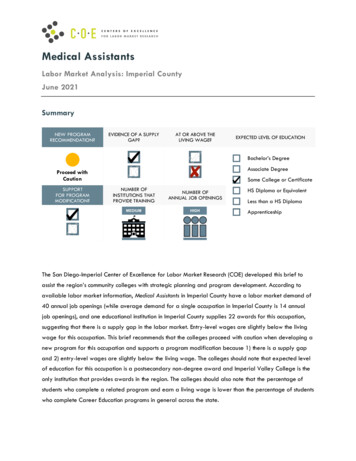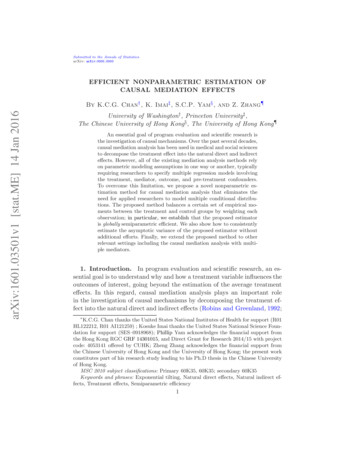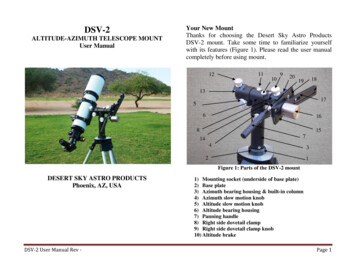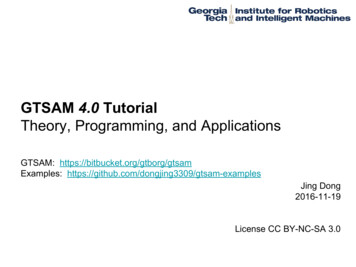![ArXiv:1208.2893v2 [astro-ph.CO] 7 Nov 2012 - UCM](/img/28/gildepaz28preprint.jpg)
Transcription
Mon. Not. R. Astron. Soc. 000, 1–? (2012)Printed 8 November 2012(MN LATEX style file v2.2)arXiv:1208.2893v2 [astro-ph.CO] 7 Nov 2012A unified picture of breaks and truncations in spiralgalaxies from SDSS and S4G imagingIgnacio Martı́n-Navarro1,2 , Judit Bakos1,2, Ignacio Trujillo1,2, Johan H. Knapen1,2,E. Athanassoula3, Albert Bosma3, Sébastien Comerón4, Bruce G. Elmegreen5,Santiago Erroz-Ferrer1,2, Dimitri A. Gadotti6, Armando Gil de Paz7,Joannah L. Hinz8, Luis C. Ho9, Benne W. Holwerda10, Taehyun Kim11,6,12,Jarkko Laine4, Eija Laurikainen4, Karı́n Menéndez-Delmestre9,Trisha Mizusawa11,13,14, Juan-Carlos Muñoz-Mateos11, Michael W. Regan15,Heikki Salo4, Mark Seibert9 and Kartik Sheth11,13,141 Institutode Astrofı́sica de Canarias, E-38200 La Laguna, Tenerife, Spainde Astrofı́sica, Universidad de La Laguna, E-38205 La Laguna, Tenerife, Spain3 Laboratoire d’Astrophysique de Marseille (LAM), Marseille, France4 Division of Astronomy, Department of Physical Sciences, University of Oulu, Oulu, FIN-90014, Finland5 IBM T. J. Watson Research Center, P.O. Box 218, Yorktown Heights, NY 10598, USA6 European Southern Observatory, Casilla 19001, Santiago 19, Chile7 Departamento de Astrofı́sica, Universidad Complutense Madrid, Madrid, Spain8 University of Arizona, 933 N. Cherry Ave, Tucson, AZ 857219 The Observatories of the Carnegie Institution for Science, Pasadena, CA, USA10 European Space Agency, ESTEC, 2200 AG Noordwijk, The Netherlands11 National Radio Astronomy Observatory / NAASC, 520 Edgemont Road, Charlottesville, VA 2290312 Astronomy Program, Department of Physics and Astronomy, Seoul National University, Seoul 151-742, Korea13 Spitzer Science Center, 1200 East California Boulevard, Pasadena, CA 9112514 California Institute of Technology, 1200 East California Boulevard, Pasadena, CA 9112515 Space Telescope Science Institute, Baltimore, MD, USA2 DepartamentoJune 2012ABSTRACTThe mechanism causing breaks in the radial surface brightness distribution of spiral galaxies is not yet well known. Despite theoretical efforts, there is not a uniqueexplanation for these features and the observational results are not conclusive. In anattempt to address this problem, we have selected a sample of 34 highly inclined spiralgalaxies present both in the Sloan Digital Sky Survey and in the Spitzer Survey ofStellar Structure in Galaxies. We have measured the surface brightness profiles in thefive Sloan optical bands and in the 3.6µm Spitzer band. We have also calculated thecolor and stellar surface mass density profiles using the available photometric information, finding two differentiated features: an innermost break radius at distances of 8 1 kpc [0.77 0.06 R25 ] and a second characteristic radius, or truncation radius,close to the outermost optical extent ( 14 2 kpc [1.09 0.05 R25 ]) of the galaxy.We propose in this work that the breaks might be a phenomena related to a thresholdin the star formation, while truncations are more likely a real drop in the stellar massdensity of the disk associated with the maximum angular momentum of the stars.Key words: galaxies: formation – galaxies: spiral – galaxies: structure – galaxies:photometry – galaxies: fundamental parameters1 E-mail:imartin@iac.es 2012 RASINTRODUCTIONThe vast majority of spiral galaxies do not follow a radial surface brightness decline mimicking a perfect exponen-
2Martı́n-Navarro et al.tial law as proposed by Patterson (1940); de Vaucouleurs(1958) & Freeman (1970). Depending on the shape of thesurface brightness distribution, a classification for face-ongalaxies has been developed by Erwin et al. (2005) andPohlen & Trujillo (2006). It distinguishes three differenttypes of profiles. Type I (TI) is the classical case, with a single exponential describing the entire profile; Type II (TII)profiles have a downbending brightness beyond the break.Type III (TIII) profiles are characterized by an upbendingbrightness beyond the break radius. Relative frequencies foreach type are 10%, 60% and 30% (Pohlen & Trujillo 2006)in the case of late-type spirals.Photometric studies of TII galaxies reveal that the radial scalelength of the surface brightness profiles changeswhen a characteristic radius ( 10 kpc) is reached. Thisso called break radius is described in several studies offace-on galaxies (Erwin et al. 2005; Pohlen & Trujillo 2006;Erwin et al. 2008) and is also found if galaxies are observed in edge-on projections (van der Kruit & Searle 1982;de Grijs et al. 2001; van der Kruit 2007). Using faint magnitude stars, Ferguson et al. (2007) found also a breakin the surface brightness profile of M 33. On the contrary, no break was detected by star counting neither inNGC 300 (Bland-Hawthorn et al. 2005; Vlajić et al. 2009)nor in NGC 7793 (Vlajić et al. 2011). Works on galaxiesbeyond the nearby Universe (Pérez 2004; Trujillo & Pohlen2005; Azzollini et al. 2008) show the presence of a break atredshifts up to z 1. These results suggest that breaks, onceformed, must have been stable for the last 8 Gyrs of galaxyevolution. Cosmological simulations (Governato et al. 2007;Martı́nez-Serrano et al. 2009) support the idea of a break inthe light distribution of disk galaxies as well.Different mechanisms explaining the origin of TIIbreaks have been proposed. All those theories can besorted into two families. A possible scenario is that thebreak could be located at a position where a threshold in the star formation occurs (Fall & Efstathiou 1980;Kennicutt 1989; Elmegreen & Parravano 1994; Schaye 2004;Elmegreen & Hunter 2006). A change in the stellar population would thus be expected at the break radius, but not necessarily a downbending of the surface mass density profile asshown by some simulations (Sánchez-Blázquez et al. 2009;Martı́nez-Serrano et al. 2009). Supporting this, Bakos et al.(2008) found that in a sample of 85 face-on galaxies (seePohlen & Trujilo, 2006), the (g ′ r ′ ) Sloan Digital Sky Survey (SDSS) color profile of the TII galaxies is, in general,U-shaped, with a minimum at the break radius, hinting ata minimum also in the mean age of the stellar population atthe break radius. This is in agreement with studies on resolved stellar populations across the break (de Jong et al.2007; Radburn-Smith et al. 2012). Furthermore, the surface mass density profile recovered from the photometryshows a much smoother behavior, in which the break isalmost absent compared to the surface brightness profile.Numerical simulations (Debattista et al. 2006; Roškar et al.2008; Sánchez-Blázquez et al. 2009; Martı́nez-Serrano et al.2009) reveal how the secular redistribution of the angularmomentum through stellar migration can drive the formation of a break. In the papers of Roškar et al. (2008) andSánchez-Blázquez et al. (2009), a minimum in the age ofthe stellar population is found at the break radius, in agreement with the results of Bakos et al. (2008). It is also re-markable that the mean break radius in the simulationsof Roškar et al. (2008) is very close (2.6 hr ) to the observational result (2.5 0.6 hr ) measured by Pohlen & Trujillo(2006), where the values are given in radial scalelength units(hr ). However, van der Kruit & Searle (1982) showed thatthe Goldreich-Lynden-Bell criterion for stability of gas layersoffered a poor prediction for the truncation radius in theirsample of edge-on galaxies. Focusing on these high inclinedgalaxies, van der Kruit (1987, 1988) proposed an alternativescenario where the break could be related to the maximumangular momentum of the protogalactic cloud, leading to abreak radius of around four or five times the radial scalelength. This mechanism would also lead to a fast drop inthe density of stars beyond the break. Observations of edgeon galaxies, such as those by van der Kruit & Searle (1982),Barteldrees & Dettmar (1994) or Kregel et al. (2002), placethe break at a radius around four times the radial scalelength, supporting this second explanation.There is a clear discrepancy between the positions of thebreaks located in the face-on view compared to those breaksfound in the edge-on perspective. In the face-on view, thebreaks are located at closer radial distances of the centerthan in the edge-on cases. Are the two types of breaks thesame phenomenon? On the one hand, the edge-on observations tend to support the idea of the maximum angularmomentum as the main actor in the break formation. On theother hand, face-on galaxies, supported by numerical simulations, favor a scenario where the break is associated withsome kind of threshold in the star formation along the disk.Only a few studies have attempted to give a more global vision of the problem (Pohlen et al. 2004, 2007) by deprojecting edge-on surface brightness profiles. Pohlen et al. (2007)and Comerón et al. (2012) found that the classification exposed at the beginning of the current paper into TI, TII andTIII profiles is basically independent of the geometry of theproblem. Consequently, the difference between the break radius obtained from the edge-on galaxies and the one fromthe face-on galaxies can not be related to the different inclination angle. More details on the current understandingof breaks and truncations can be found in the recent reviewby van der Kruit & Freeman (2011, §3.8).Despite truncations in edge-on galaxies and breaks inface-on galaxies have been traditionally considered equivalent features, our aim in the current paper is to understandthe already noticed observational differences, proposing aglobal and self-consistent understanding of the breaks. Weuse images in six different filters (five SDSS bands and theS4 G 3.6µm band) to study the radial surface brightness distribution in a sample of 34 edge-on galaxies. We also measure the color and the stellar surface mass density profilesfor each object, trying to constrain the most plausible mechanism for the break formation.The layout of this work is as follows: in Section 2 thecharacteristics of the sample are presented. Section 3 describes how the profiles are measured. The analysis is shownin Section 4 and then we discuss the results in Section 5.The main conclusions listed in Section 6. Tables referencedin the paper are in Appendix A.Throughout, we adopt a standard ΛCDM set of cosmological parameters (H0 70 km s 1 Mpc 1 ; ΩM 0.30;ΩΛ 0.70) to calculate the redshift dependent quantities.We have used AB magnitudes unless otherwise stated. 2012 RAS, MNRAS 000, 1–?
A unified picture of breaks and truncations2SAMPLE AND DATAOur sample of galaxies has been selected to cover edge-onobjects present both in the Sloan Digital SDSS Data Release7 (Abazajian et al. 2009) and in the Spitzer Survey of StellarStructure in Galaxies (S4 G) (Sheth et al. 2010). We find 49highly inclined (inclination & 88 ) objects satisfying thiscriterion. In this sense our sample is neither volume limitednor flux limited.For each object, the morphological type, the correctedB-band absolute magnitude (MB ) and the maximum velocity of the rotation curve were obtained from the HyperLeda database (Paturel et al. 2003). Using the NASA/IPACExtragalactic Database (NED) (Helou et al. 1991) we obtained most distances from primary indicators, except forthree cases (PGC 029466, UGC 5347 and UGC 9345) wherethe distance was obtained using the redshift.Finally, from the original 49 galaxies, we keep only thoseobjects brighter than MB 17 mag and with morphological type Sc or later. Table A1 summarizes the generalinformation available for each galaxy in the final sample.We focus our studies on late-type spiral galaxies. These lateHubble-types are known to have the most quiescent evolution during the cosmic time, hence the fossil records imprinted by the early galaxy formation and evolution processes likely survive to present day.2.1SDSS dataFor all the galaxies in the sample, the SDSS data were downloaded in all the five available bands {u′ , g ′ , r ′ , i′ , z ′ }. SDSSobservations are stored in the format of 2048 1489 pixel( 13.51’ 9.83’) frames that cover the same piece of sky inall bands. These frames are bias subtracted, flat-fielded andpurged of bright stars, but still contain the sky background.These frames might not be large enough to contain extendedobjects completely. For this reason, to assemble mosaics thatare large enough to study extended objects, we needed todownload several adjacent frames from the SDSS archive.We estimate the sky background of these frames independently (see §3.0.1 for a more detailed description) and then,we assemble the final mosaics in all five bands, centered atthe target galaxy, by using SWARP (Bertin et al. 2002).The pixel size in the SDSS survey is 0.396 ”, and the exposure time is 54 sec. From this, we calculated the surfacebrightness in the AB system as:µSDSS 2.5 log(counts) ZPZP 2.5 0.4 (aa kk airmass) 2.5 log(53.907456 0.3962 )where aa, kk and airmass are the photometric zero point,the extinction term and the air mass, respectively. Theseparameters are stored in the header of each SDSS image.2.2S4 G dataThe S4 G project is a survey of a representative sample ofnearby Universe galaxies (D 40 Mpc) that collects imagesof more than 2000 galaxies with the Spitzer Infrared ArrayCamera (IRAC); Fazio et al. (2004). In particular, we are 2012 RAS, MNRAS 000, 1–?3interested in the 3.6µm band (channel 1) which is less affected by dust than the SDSS optical bands and is a goodtracer for the stellar mass in our galaxies. The fact that theoptical depth in this band is lower than in the SDSS imagesis crucial as we are dealing with edge-on objects, with a lot ofdust along the line of sight. The IRAC 3.6µm images were reduced by the S4 G team. They have a pixel scale of 0.75 ”/pixand a spatial resolution is 100 pc at the median distanceof the survey volume. Also, the azimuthally-averaged surface brightness profile typically traces isophotes down to a(1σ) surface brightness limit 27 mag arcsec 2 (see Shethet al. 2010). The conversion to AB surface magnitudes isgiven by:µS4 G 2.5 log(counts) 20.4723DATA HANDLING AND RESULTS3.0.1Sky subtractionSince the breaks are expected to happen at low surfacebrightness (a typical value of 24 mag arcsec 2 in the SDSSg ′ band was found by Pohlen & Trujillo 2006 for face-ongalaxies), a very careful sky estimation is needed to obtainreliable results. In this context, working with data takenwith different instruments at different wavelengths, requiresa different treatment for the SDSS and S4 G data.In the case of the SDSS images, after removing the 1000counts of the SOFTBIAS added to all SDSS chips, we measure the fluxes in about ten thousand randomly placed, fivepixel wide apertures. We apply a resistant mean1 to thedistribution of the aperture fluxes, and carry out several iterations to get rid of the fluxes biased by stars, and otherbackground objects. The mean of the bias-free distributionprovides accurate measurement of the sky background, andis then subtracted from the chips.For the S4 G data, the sky treatment was completely different because of the presence of important gradients acrossthe images (see Comerón et al. 2011). The adopted strategywas to mask every object in the image and then make a loworder polynomial fit of the background in the same way thatComerón et al. (2011) did in their study of NGC 4244. Inorder to establish a threshold between sky/non-sky pixels,we built the histogram of the image and, with the assumption that this histogram is dominated by the sky pixels, wecalculated the maximum and the FWHM of this distribution. The FWHM measured in that way can be associatedwith an effective sigma (σe ) that we supposed representative of the standard deviation of the background. After this,we performed five two-dimensional fits with five differentpolynomial orders (O {0, 1, 2, 3, 4}), including only thosepixels with a value between the maximum of the histogram 3σe . The outcome of this stage was five sky-subtractedimages, each one derived from one of the fits. The difference between these images was used (see §3.1.2) to establishthe surface brightness limit in the 3.6µm surface brightnessprofile. In Fig. 1 we show a raw S4 G image (left) where the1The resistant mean trims away outliers using the median andthe median absolute deviation. It is implemented as an InteractiveData Language (IDL) routine.
4Martı́n-Navarro et al.Figure 2. The fraction of non-background pixels within the slitaperture (FO ) as a function of the position angle of the slit forNGC 4244 (r ′ -band). The vertical dashed line marks the centerof the angular interval used to refine the measurement of the finalPA.gradients across the image are obvious; the mask image (center) with the pixels used to fit the background representedin white and, as an example, the 3rd order sky subtractedimage (right).3.0.2Estimating the position angle of the slitOur aim is to extract surface brightness profiles along thedisk in a slit that represents the same physical distance (1.2kpc) vertically in all galaxies. For this reason, this slit has tobe aligned accurately with the disk of our galaxies. The position angle (PA) was defined as the angle that maximizes thetotal number of non-sky pixels within the previously fixedslit. This definition is consistent with the idea followed in thesurface brightness profile calculation. The measurement willbe robust if the size of the galaxy is large enough comparedto the field of view. As in §3.0.1, we distinguished sky pixelsfrom non-sky pixels, setting them to 0 and 1 respectively.We rotated the image by a certain angular step and thensum the value of all the pixels within the slit. The desiredangle corresponds to the maximum of this distribution.In order to obtain the PA with enough accuracy, butwith an acceptable computational cost, the process was divided into two phases. In the first one, a low resolution profile was obtained by rotating the galaxy between 0 and 180 in 100 consecutive steps. We then defined an angular intervalaround the maximum of the resulting low resolution profileand used a high resolution step of 0.2 . The maximum foundin this second phase is the PA of the galaxy. Fig. 2 showsthe normalized fraction of flux within the aperture vs theslit position angle profile for the case of NGC 4244, with apeaked distribution around the maximum (PA 47.2 ).As the galactic plane is expected to be dust attenuated,we employed the 3.6µm S4 G images to calculate the PA.The PA derived form the SDSS data was in all the casescompatible with the S4 G measurements taking into accountthe associated errors. In addition, we repeated the measurement of the PA changing the threshold used to distinguishthe sky pixels, taking at the end the average of the resultingvalues.The PA calculated in this way is intuitive but is sensitive to the presence of extended objects in the field andto asymmetries in the light distribution of the galaxy. Forthat reason, we had to manually set the PA in seven cases tocompletely align the galactic plane with the slit, with a typical deviation with respect to the automatic measurementhP Afinal P Aauto i 0.5 0.1 . The PA here calculatedis compared in Table A2 with the position angle from HyperLeda2 for each galaxy in the sample, showing a meandifference between our measurements and the PA from HyperLeda 0.7 . It is worth noting here that the PA givenby HyperLeda is the result of averaging all entries in thedatabase for each object, sometimes with very different values (e.g. for NGC 4244, the HyperLeda PA (42.2 ) is the average of four significantly different measurements: 48 , 48 ,27 and 45.2 ).3.0.3Image maskingTo study the outskirts of the galaxies with the desired precision it was necessary to mask objects that clearly do not belong to the galaxy (foreground stars, background galaxies).This masking process allowed us to obtain cleaner surfacebrightness profiles and also to avoid the contamination ofthe faintest parts by external objects.For the S4 G images, the masks were supplied by theS4G team and are described in Sheth et al. (2010). In thecase of the SDSS images, we generated the masks using thepackage SEXTRACTOR (Bertin & Arnouts 1996). Background objects and foreground stars were detected usinga master image composed of all five SDSS bands, scaled tothe r ′ -band flux. Then, over-sized elliptical masks were placeonto the detected sources using SEXTRACTOR parameterssuch measured flux, elongation and similar. To increase theaccuracy in this process, the masking was done in two consecutive steps. In the the first one, the bigger and brighterbackground objects were masked. In the second step, we performed a more detailed detection process to mask any possible remaining object in the field. By doing this, we couldsuccessfully mask background objects within a wide rangeof sizes.3.1Surface brightness profilesTo extract the profile along the radial distance of the galaxies, a slit of constant physical width is placed over the galactic plane and then used to calculate how the flux varies alongthe slit. The width of the slit was fixed to 1.2 kpc following the assumption of a vertical scalelength equal to 0.6 kpc(Kregel et al. 2002). For illustrative purposes, in Fig. 3 theslit position (in blue) is shown over the r ′ -band image ofNGC 5023.In general, the process to obtain the surface brightnessprofiles was the same for the SDSS and for the S4 G data. Thefirst step was to divide the slit along the major axis in cellsof 0.3” radial width. The averaged value of the flux withineach cell was calculated using a 3σ rejection mean. Thisfirst stage yields a crude estimate of the surface brightness2 By definition, the PA increases (from 0 to 180 ) from theNorth to the East, i.e., counterclockwise. 2012 RAS, MNRAS 000, 1–?
A unified picture of breaks and truncations5Figure 1. Sky subtraction steps for NGC 4244 (3.6µm band). From left to right: 1- Original image. 2- Image mask where white pixelsare those used to estimate the background shape. 3- Image after the subtraction of one of the polynomial fittings (3rd order).Figure 3. The galaxy NGC 5023 is shown with the region (slit)used to calculate the surface brightness profile delimited by thesolid blue lines.profile. The center of the galaxy was supposed to correspondto the brightest cell of this profile and, to avoid any kind ofmisalignment between the different filters, we took the rightascension and declination of the S4 G brightest cell as thecenter in all the other profiles. The sky was again measuredon the left and right sides of the galaxies in order to, later,remove any possible residual contribution after the initialsky subtraction (§3.0.1).After that, we calculated the right and left surfacebrightness profiles with the size of the bins linearly increasing with a factor 1.03 between consecutive cells to improvethe signal to noise ratio in the outskirts of the galaxies. Theright/left residual sky value measured at the beginning ofthe process was also subtracted for the right/left profiles toobtain the final surface brightness distributions. The surfacebrightnesses of this residual sky corrections were typically 30 mag arcsec 2 for the g ′ -band and 29 mag arcsec 2for the 3.6µm band.Finally, a mean profile was constructed as the averageof the left and right profiles. These averaged profiles are theones used in this study. Looking at the individual right/leftprofiles of all our sample, it was clear that in some cases(e.g. NGC 4244) there are considerable asymmetries (up to0.8 r ′ -mag arcsec 2 difference between the averaged profileand the right/left profiles at r 550 arcsec for that object) 2012 RAS, MNRAS 000, 1–?Figure 4. Surface brightness profile for the galaxies NGC 5907(upper panel) and NGC 4244 (bottom panel) in the r ′ band. Inblue it is shown the mean profile, whereas left and right profilesare represented in red and yellow respectively.but as we wanted to explore the surface brightness profilesdown to very faint regions, the combination of the two sidesof the galaxies is necessary. As an example, in Fig. 4 werepresent the mean, left and right surface brightness profilein the SDSS r ′ -band for a symmetric case (NGC 5907) inopposition to the more asymmetric galaxy NGC 4244.Beyond a certain radius, the sky subtraction becomes adominant factor at determining surface brightness profiles.Having used different sky subtractions techniques, the max-
6Martı́n-Navarro et al.imum radial extension of a reliable surface brightness profileneeds to be measured separately for the SDSS and for theS4 G data.profiles). In particular, we calculated for each galaxy the(g ′ r ′ ), (r ′ i′ ) and (r ′ 3.6µm) color profiles.3.33.1.1To estimate how faint we can explore the SDSS profiles,we defined a certain critical surface magnitude (µcrit ) thatsets the limit for our profiles. Following Pohlen & Trujillo(2006), we defined µcrit as the surface brightness where thetwo profiles obtained by under/over subtracting the sky by-1/ 1 σsky start to differ by more than 0.2 mag arcsec 2where σsky is given by22σsky σsky,2left σsky,rightwith σsky, left and σsky, right the standard deviation of theresidual sky measured on the left and right sides of thegalaxy. On average, we could reach a surface brightnessmagnitude limit equal to 26.1 0.1 mag arcsec 2 in theSDSS r ′ band. This value is a characteristic limit for theg ′ , r ′ and i′ SDSS data, with the remaining SDSS imagesbeing typically shallower (e.g. hµu′ ,lim i 25.7 mag arcsec 2; hµz ′ ,lim i 24.2 mag arcsec 2 ).3.1.2S4 G surface brightness limitThe limit for the S4 G data had to be more strictly definedbecause of the presence of gradients across the S4 G images.As discussed in §3.0.1, we have, for each object, five imagesfrom five different polynomial fits to the background. Thelimit was established where the function1 Xµcrit µn hµi 5 n 0,.,4became greater than 0.2 mag arcsec 2 . In other words, thelimit for the S4 G profiles was placed where the mean difference between the five profiles and the mean one was greaterthan 0.2 mag arcsec 2 . A typical value of 26.1 0.2 magarcsec 2 was found for this limit in the S4 G 3.6µm band.The limit defined in this a way is not necessarily thesame for the left and right sides of a galaxy. The mean profile is in fact the average of two profiles until the surfacemagnitude limit of the “shallower” side. Beyond that, themean profile is only that of the “deeper” side of the galaxy.3.2Stellar surface mass density profilesSDSS surface brightness limitColor profilesFrom the surface brightness profiles one can directly obtainthe radial color profiles of an object. However, the interpretation of the edge-on color profiles is not straightforward.On the one hand, the presence of dust in the galactic planewill generate redder colors and change the actual shape ofthe color profile compared to that expected in its absence.On the other hand, effects related to the edge-on projection(integration of light from different radii along the line ofsight and a bigger optical depth because of the presence ofdust) are difficult to handle and to account for in an edge-oncolor profile.In this work, we have focused only on those profiles thatcould reach the lowest surface brightness values (i.e., thecolor profiles derived from the deepest surface brightnessThe final quantity that we obtained from the images is thestellar surface mass density (Σλ ). We can relate Σλ with thesurface brightness at a certain wavelength (µλ ) and with themass to luminosity ratio (M/L)λ at that given λ (see Bakoset al. 2008) using the following expression:log Σλ log(M/L)λ 0.4(µλ mabs ,λ ) 8.629 2where Σλ is given in M pc . Having µr′ from the photometry, one just needs to know the value (M/L)r′ along thegalaxy to get the Σλ profile. We used the relation proposedby Bell et al. (2003) to estimate (M/L)r′ as followslog(M/L)r′ [ar′ br′ (g ′ r ′ )] 0.15where ar′ and br′ are 0.306 and 1.097 respectively. Wehave then the stellar surface mass density as a function ofall known variables.As mentioned in §3.2, the interpretation of edge-on colorprofile is not as direct as in the face-on case. The dust attenuation and the error propagation in this kind of profiles arevery important and thus, one has to be aware of all theseeffects while interpreting the surface mass density profiles.3.4Presentation of the resultsShortly bellow we will show some examples of the profilesextracted in this work. For the rest of the galaxies, we referto the reader to Appendix B. Upper left panels in thesefigures show the six bands surface brightness profiles usedin this paper. The dashed vertical lines mark those radiiwhere a change in the exponential behavior happens definedas described in §4.3.On the bottom left panel we represent the color profiles.The color profile are shown down to the distance where datapoints have an error less than or equal to 0.2 mag, with theerror calculated as the quadratic sum of the errors in theindividual surface brightness profiles.The bottom right panel is occupied by a g ′ -band imageof the galaxy, with vertical lines marking the characteristicradii, in the same way as in the surface brightness profiles.The angular distance from the center of the galaxy to thoselines is shown at the top of the image.Finally, the upper right panel shows the stellar surfacemass density profile. In the same panel is over-plotted the3.6µm surface brightness profile, that is expected to be agood tracer of the stellar mass density. In this panel wehave not limited the extent of the profiles and therefore thefarthest points have to be considered with caution.44.1ANALYSISBreak radius and scalelengthsIn order to quantify the radial distance where the change inexponential scalelength occurs, we have linearly fitted the r ′ band averaged surface brightness profile of each galaxy. We 2012 RAS, MNRAS 000, 1–?
A
2 SAMPLE AND DATA Our sample of galaxies has been selected to cover edge-on objects present both in the Sloan Digital SDSS Data Release 7 (Abazajian et al. 2009) and in the Spitzer Survey of Stellar Structure in Galaxies (S4G) (Sheth et al. 2010). We find 49 highly inclined (inclination & 88 ) objects satisfying this criterion.




![arXiv:1208.1409v1 [astro-ph.CO] 7 Aug 2012](/img/28/pp12055.jpg)




![arXiv:1410.0009v1 [astro-ph.GA] 30 Sep 2014](/img/28/pp14101.jpg)
![3 3, y z x arXiv:2005.00047v3 [astro-ph.EP] 19 Oct 2020](/img/56/mann-2020-tess-hunt-for-young-and-aj-aam.jpg)